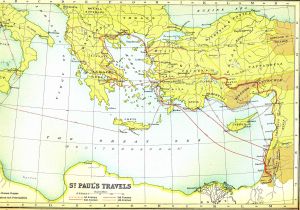Difference between revisions of "Colossae"
Graham grove (talk | contribs) |
(Change infobox_contents toc name) |
||
| (4 intermediate revisions by 3 users not shown) | |||
| Line 1: | Line 1: | ||
| − | + | {{Infobox_Contents | | |
| − | + | topic_name = Colossae | |
| − | + | [[Image:Paul's Missionary Journeys Small.jpg|thumb|center|a map of the regions that [[apostle Paul|Paul]] travelled. Colossae is in grid I-4]] | | |
| − | + | subtopics = [[Epistle to the Colossians]] | | |
| − | + | opinion_pieces = {{short_opinions}} | |
| − | + | * {{ebd}} | | |
| − | + | }} | |
| − | {{ | ||
| − | |||
| − | {{ebd}} | ||
| − | |||
| − | |||
Colossae (or Colosse) was an ancient city of [[Phrygia]] (in current day [[Turkey]]), on the [[Lycus River]], which is a tributary of the [[Maeander River]]. It was situated about 12 miles above the city of [[Laodicea]], and near the great road from [[Ephesus]] to the [[Euphrates]]. The site, located in what is now Anatolia in Turkey, has never been excavated. | Colossae (or Colosse) was an ancient city of [[Phrygia]] (in current day [[Turkey]]), on the [[Lycus River]], which is a tributary of the [[Maeander River]]. It was situated about 12 miles above the city of [[Laodicea]], and near the great road from [[Ephesus]] to the [[Euphrates]]. The site, located in what is now Anatolia in Turkey, has never been excavated. | ||
Latest revision as of 17:40, 27 November 2009
Colossae
 a map of the regions that Paul travelled. Colossae is in grid I-4 | |
| RELATED TOPICS | |
| SERMONS, ESSAYS AND OPINIONS | |
| CONTENTS | |
Colossae (or Colosse) was an ancient city of Phrygia (in current day Turkey), on the Lycus River, which is a tributary of the Maeander River. It was situated about 12 miles above the city of Laodicea, and near the great road from Ephesus to the Euphrates. The site, located in what is now Anatolia in Turkey, has never been excavated.
Early ancient history
In 396 BC, during the Persian Wars, the satrap Tissaphernes was lured to Colossae and killed by an agent of King Cyrus.
The historian Pliny told that the wool of Colossae gave its name (colossinus) to the colour of the cyclamen flower.
During the Hellenistic period, the town was of some mercantile importance, although by the first century it had dwindled greatly in size and significance.
History in early church times
The apostle Paul wrote an letter (Epistle to the Colossians) to the church at Colossae. It does not appear that he had visited this city when he wrote his epistle since he wrote to Philemon of his hope to visit Colossae upon being freed from prison (Philemon 1:22). It seems that a man named Epaphras was the founder of the Colossian church.
Medieval History
The town eventually fell into decay, possibly due to an earthquake. The Byzantine town of Chonæ (Kona) occupied a site near its ruins.
The town was the birthplace of the mediaeval writers Nicetas and Michael Choniates.
In Byzantine and Russian art, the theme of the Miracle of the Archangel Michael at Kona is intimately interlocked with the site. The Monastery of the Miracle in the Moscow Kremlin, where the Russian tsars were baptized, was dedicated to the feast of the Miracle at Kona.
Quotes
Links
Return to Places